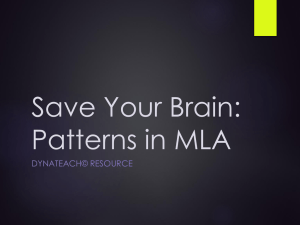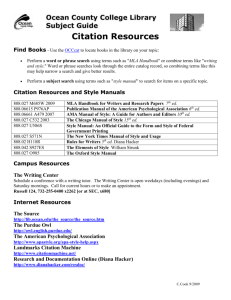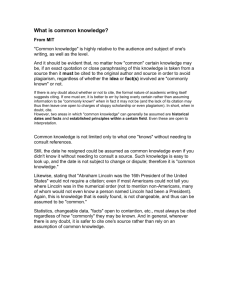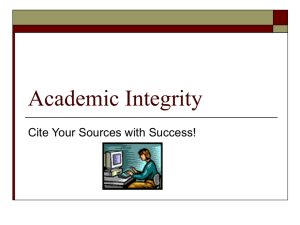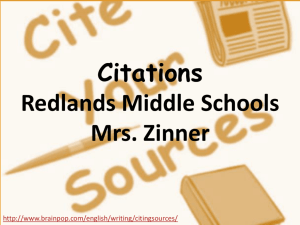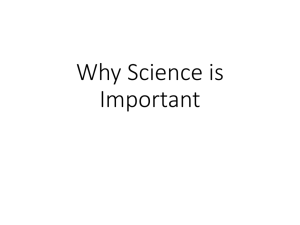Saving Your Brain: A Guide to Understanding MLA Citations
advertisement
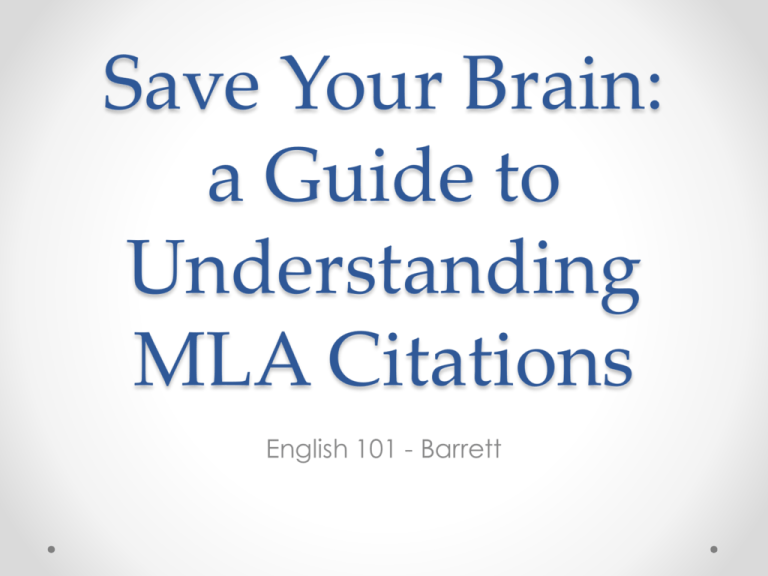
Save Your Brain: a Guide to Understanding MLA Citations English 101 - Barrett Why does it exist? • “MLA style for documentation is widely used in the humanities, especially in writing on language and literature. Generally simpler and more concise than other styles, MLA style features brief parenthetical citations in the text keyed to an alphabetical list of works cited that appears at the end of the work.” ~mla.org Part I: Bibliography and Work(s) Cited Entries Part I of II See the Pattern Who? •Author What? •Title Where? •Where did it come from? (Specific) •Were did you find it? (General) When? •Date accessed Example Who? Periods demarcate units of information • McConnell, D. Frank. What? Specific > General • “H.B. Wells: Utopia and Doomsday.” Where? • The Wilson Quarterly 4.3 (1980): 176-186. • JSTOR. • Web. When? • 2 November 2013. Example cont. 1. 2. 3. 4. 5. McConnell, D. Frank. “H.B. Wells: Utopia and Doomsday.” The Wilson Quarterly 4.3 (1980): 176-186. JSTOR. Web. 2 November 2013. McConnell, D. Frank. “H.B. Wells: Utopia and Doomsday.” The Wilson Quarterly 4.3 (1980): 176-186. JSTOR. Web. 2 November 2013. Identifying “Where” Got a journal? Realize you’re identifying the specific location in the journal Journal Name Edition + Year Page Numbers The Wilson Quarterly 4.3 (1980): 176-186. Electronic Sources (Online Journal Articles, Web Pages, YouTube, etc) • Author o Editor • Article title in quotation marks • Title of the Website, project, or book in italics. • Version number, including revisions, posting dates, volumes, or issue numbers. • Publisher information o publisher name o publishing date • • • • Take note of any page numbers (if available). Medium of publication. Date you accessed the material NO URLs Citing a Web Site https://owl.english.purdue.edu/owl/resource/747/08/ Citing a Book https://owl.english.purdue.edu/owl/resource/747/06/ Part II: In-Text Citations Part II of II Cite a Quotation 1. Copy the necessary bibliographical information o author, title, publisher, city, & date 2. Place quotation marks around the information (quote) 3. Insert the quote in your text and use parentheses to share the author & pg. # Cite a Quotation • Is this citation correct? Some believe that Hamlet is the most important character in Western Literature: “The phenomenon of Hamlet is unsurpassed in the West’s imaginative literature” (Bloom 384). Cite Paraphrases • Is this citation correct? Some argue that Shakespeare’s Hamlet is meant to be an almost biblical character. He is charismatic, not unlike King David from the Bible (Bloom 384). What to Cite • No, just specific, not readily accessible information… • You need not cite: o Familiar proverbs o Well-known quotations o Common knowledge Common Knowledge NO CITATION: • Abraham Lincoln was the 16th president • Hawaii was the 50th state • Golden Retrievers are popular pets • Mel Gibson played William Wallace Uncommon Knowledge INCLUDE CITATION: • Abraham Lincoln regretted appointing George McClellan • Alaska was going to originally be incorporated as two separate states • Golden Retrievers bite more humans per year than any other dog breed • Mel Gibson fabricated many of the details of William Wallace’s life Plagiarism or Not? Ernest Hemmingway was a notable author but he was also probably clinically depressed. He suffered from well documented bouts of depression and eventually committed suicide in 1961. Workers at his Cuba hacienda often praised his gentle nature, but they also speak of long periods where Hemmingway would sit alone refusing any visitors. (Thomas, 43) Nope • Though nothing is directly quoted, there is some uncommon knowledge. Citation is given in a place that does not disrupt the flow of information. Plagiarism or Not? The difference between Orwellian satire and Swiftonian satire is usually the level of hyperbole created in the setting. Orwell’s satire, while certainly filled with hyperbole, maintains a believability according to critics, while Swift’s satire is never meant to be believed. YES! • No direct citation here • True, this could be the author’s own assertion, but in this case it’s not. • It should’ve been cited. They merely mention “critics”. Plagiarism or Not? Though there is little character development in A Midsummer Night’s Dream and no true protagonist, critics generally point to Puck as the most important character in the play. The mischievous, quick-witted sprite sets many of the play’s events in motion with his magic, by means of both deliberate pranks on the human characters (transforming Bottom’s head into that of an ass) and unfortunate mistakes (smearing the love potion on Lysander’s eyelids instead of Demetrius’s). YES! • These lines are lifted directly from Sparknotes.com! • Here’s how the lines could’ve been cited correctly… See how easy this is! “Though there is little character development in A Midsummer Night’s Dream and no true protagonist, critics generally point to Puck as the most important character in the play. The mischievous, quick-witted sprite sets many of the play’s events in motion with his magic, by means of both deliberate pranks on the human characters (transforming Bottom’s head into that of an ass) and unfortunate mistakes (smearing the love potion on Lysander’s eyelids instead of Demetrius’s)” (Sparknotes). Consequences of Plagiarism • • • • • • College notification Zero on assignment Failing grade in the class Detention Call home More…
